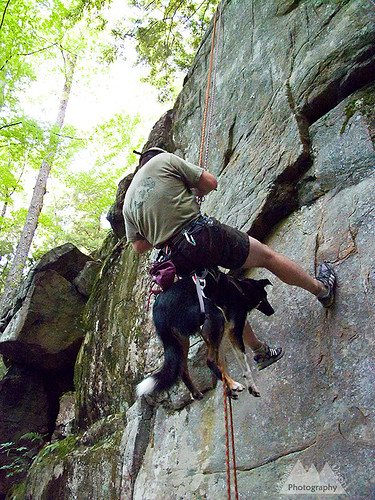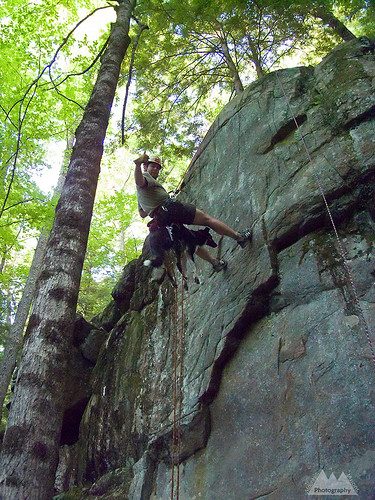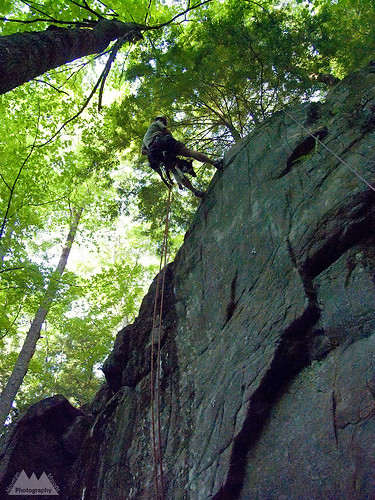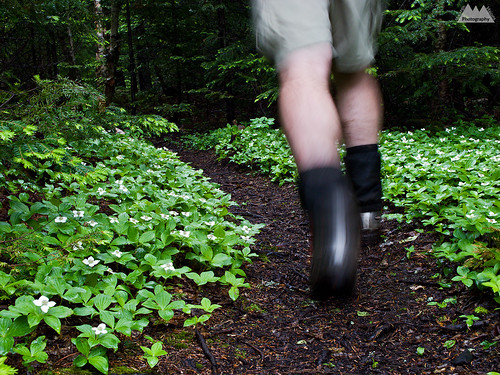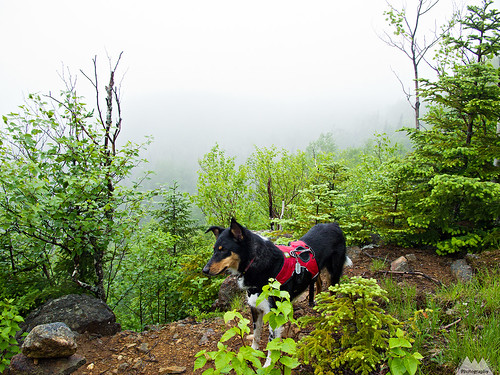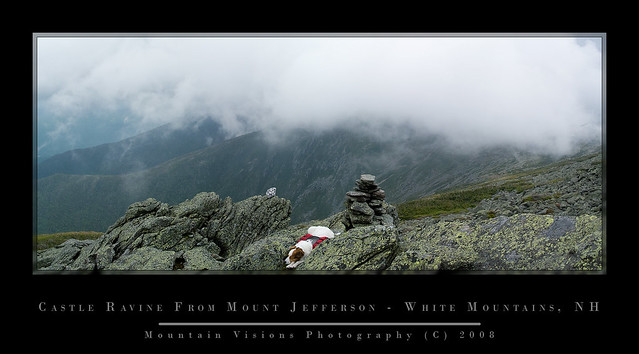 |
| Caney, a shelter rescue, on the hike out after 3 days of ascending the most technical trails in the Northern Presidential's. |
Recently, while checking a forum for my lost trekking poles, I noticed someone asking where they could buy a Chocolate Lab to share their love of the trail. Everyone has their reasons for doing different things, but there is almost no way to justify buying a Lab from a breeder. This is one of the most over bred and common dogs available. Everyone loves Labs, big, lunky, dumb but highly trainable, lazy and loyal. The best trait of Labs, in my opinion, is they are a good dog for weekend warriors. They are content to lay around all week, but will hike/swim till either you stop, or their paws fall off on weekend outings.
Beyond that, there is entirely no reason to buy a "trail dog". The majority of trick dogs, agility dogs and even Search and Rescue (SAR) dogs are shelter dogs. As a matter of fact, it's arguable SAR dog training is probably the most mentally and physically demanding of all dog training...hiking an average Class 2-3 trail should be cake for the average dog! Exceptional dogs should be able to climb 4th and easy 5th class, but I have yet to see a breeder advertising climbing dogs.
Health, durability, and breed specific traits:
It used to be believed that purebred dogs were healthier and more prone to living long lives. However, it's now widely accepted that mutts are healthier. There is a simple reason for this, Darwin's theory on natural selection and evolution is clearly at play in mutts. Recessive genes are weeded out quite quickly as weak animals die before they are able to reproduce. Not to mention, no one is breeding sickly mutts, but many home breeders and puppy mills do breed weak and sickly pure breeds. They then sell them off to unsuspecting neophyte dog enthusiast. They are able to sell these dogs because of a precious (yet entirely meaningless) AKC lineage paper, and you are stuck with an awful dog that probably will end up in a shelter or dead on the street. The best "trail dog" in the world is probably in a pack of strays on some Indian reservation in the Dakotas. So if you care about durability and longevity, head out to the reservation and get you a stray!
Unless you are a show dog trainer, or you need a dog to perform a very specific task, or perhaps need a hypoallergenic dog, there really is no reason to buy a dog. Just because a dog has it's "papers" doesn't mean it has good traits or will be a good dog. For instance, not all Border Collies have a strong herding instinct. And believe me, if you live in a suburban neighborhood, where the only thing to herd are kids and cars, you do not want a dog with this instinct. However, if you are a rancher, you probably do want that very same dog.
Most people breeding aren't breeding traits, they are breeding breeds! The best breeders don't sell dogs for $50, $100, 200, 500, $750, etc, these dogs are $1500-2500 or more, have just one litter a year, and they are dogs with winning heritage at some aspect of their breed, whether herding, working, protection/law enforcement, etc. These dogs aren't being bred for their looks, rather they are bred because they have a strong pedigree of traits or physical prowess.
So where am I'm going with this? It's simple, you should never buy a dog from a pet store, puppy mill, or home breeder, because there are millions more dogs in this world than people to take care of them. Buying from home breeders just encourages breeding. And it's not the breeders fault. If I want to make a few thousand dollars extra a year, I might consider buying 2 "pure bred" Border Collies with papers and breeding them. You say, "if they are already born, it's not hurting anyone to buy them." Yes it is. It's enabling. If you wait till those puppies hit 6-9 months, chances are they will be in a shelter or given away for free. A few litters later those breeders start to lose interest in losing money on shots and feeding, they eventually toss in the towel.
Pros of getting a shelter dog:
1) Puppies are cute, they have to be or we'd probably kill them for all the havoc they wreak. Most shelters don't have "true" puppies, and that in itself saves you from a lot of expense! A lot of these dogs come vaccinated and neutered, saving you time and money! Shelters that do have real puppies usually adopt them out before they are even born; sight unseen. We were at one shelter where a woman was taking the train and then a cab from NYC, 4 hours upstate to claim her puppy. It's crazy, and should tell you how dumb it is to be puppy crazy.
2) Getting a young non puppy or adult dog has it's advantages. You can often get a good idea of the temperament of a 6 month old dog or a 5 year old dog, but puppies are very tough to figure out for the novice dog trainer. By getting an older dog you also won't end up with an adorable puppy that turns out to be a not so cute adult dog. Remember #1, we tolerate puppies because they are so darn cute, once they are adults that puppy cuteness has worn off. When we were looking for a new dog, my wife kind of wanted a puppy, but I just looked at them and wondered how they were gonna look, how their temperament was going to be; and most importantly, how many extra months it would be till they were ready for some real training.
3) Pound puppies are rarely problem dogs, many came from good homes that cared for them but were forced to give them up. Allergies, money, living situation, death, or change of careers are all non problem dog reasons why some dogs end up in shelters. Besides, you don't want to hear my tirade that problem dogs are the result of problem people, do you? A lot of adult shelter dogs are house broken to boot. And lets face it, training a dog can be fun, but cleaning up accidents is never fun!
4) No one will ever ask you for your dogs "papers" on the street, but if you must have a specific breed, there are many breed specific rescues. Dogs at these rescues are evaluated for temperament and health, and then they are matched to good homes based on an extensive application process. In a sense the breed specific rescue is what a real breeder would do. Analyze traits and temperament and match them to the needs of the buyer. Of course your local shelter probably has a few of those puppy mill purebreds to. One more thing "rescues" do like a real breeder, if at any point you decide the dog isn't for you, they will take it back. Yes, real breeders will take your dog back without question, so do rescues. Try that at the pet store, puppy mill, or home breeder!
5) You are doing a good thing for several reasons. You are rescuing a dog that could be put to death, you are opening a space for another dog at that shelter, you are not giving puppy mills and amateur home breeders profits to continue to over breed. I'll state this again, if you buy from a puppy mill or home breeder, you are the problem!
6) Think about the money you are spending to buy a "pure breed", now think about the millions of dogs in shelters. If you rescue a shelter dog, you could donate the money you saved paying a breeder to keep more shelter dogs alive. Shelters aren't free, there is no such thing as free medical care, and dogs do get put to death.
7) Within a few months of spending time training and playing with your new dog, teaching him/her how to hike, swim, behave in a boat, climb up ladders and rocky trails, etc, you will not care one bit if it's the breed you thought you wanted in the first place.
Cons of getting a shelter dog:
The biggest reason I can see for buying or seeking a specific breed is getting the best likelihood of the traits you prefer in a dog. The problem is, part of the dog expressing those traits is the way it is trained and nurtured. Buying a specific breed guarantees nothing, it only increases your chances. If you buy a dog from parents of the finest trail dogs in the world, and lock it in a closet for 3 years, good luck on the trail! However, as expressed above, unless you are buying from a top breeder who specializes in the traits you desire, you are always playing Russian Roulette.
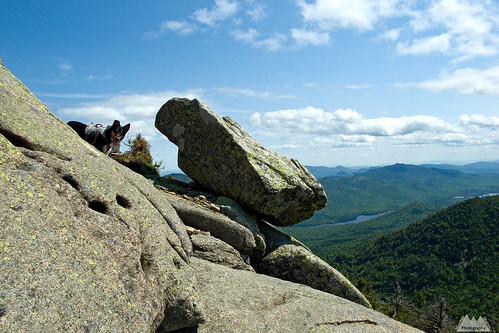 |
| Colvin, a shelter rescue, on the south summit of Saddleback Mountain. The trail that was ascended to this point is considered by many the most technically difficult in the Adirondacks. |
Where to rescue from:
There are many options. With the Internet you can literally browse dogs from all over the country and have one shipped to you for a reasonable fee. Colvin cost $175 to ship from Arkansas, which was a very fair price. The South typically has more rescues than the North. In combination with lower human population, lower spay/neuter compliance, and more kill shelters, they will often ship dogs up north to keep them from being euthanized. Many rescues and shelters will send you videos of the dogs you are interested in, as well as additional pictures. They will cat, dog, kid, leash, and car test. They will do almost anything you need them to do to make sure it's the right dog for you. They'll even take the dog back if it's not the dog for you. This is also something a top end breeder will do, but not a puppy mill.
It's kinda funny, really, these people (rescues and shelters) will bend over backwards to get you the right dog, but instead many people will play Russian Roulette with a "pure breed" from the equivalent of a shady used car salesman! Does that make sense?
The beauty of all of this is, while you are doing a really good thing, you are in many ways getting a more customized dog than you would have gotten had you bought a puppy for $500 from the woman down the block at 6 weeks old.
If you've been offended by any of this post, well, the truth is ugly, but it's the only way to combat a serious and somewhat solvable problem.
Keep an eye out for some guidelines to selecting and training a trail dog in a future blog post. I'm no expert, but you'd be surprised at how many people get a puppy and toss a 15lb pack on it's back, then head off to hike the Great Range, without any thought to the undertaking.
 |
| Colvin, a shelter rescue, leading the way up the summit of New Hampshire's Mount Adams under full winter conditions. Despite dozens of humans attempting, he was one of only three total individuals to summit on that particular day. |
